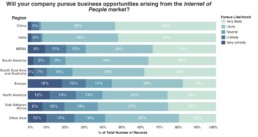Mobile technologies and connected digital platforms are opening up new opportunities to deliver healthcare to low-income, remote communities. A key element of this connectedness is the Internet of People, which refers to the digitalisation of relationships between people and the collection of personal data, and enables more personalized, predictive, participatory, and preventive healthcare.
You only understand the preciousness of healthcare once you need it – and the 400 million people around the world who lack access to healthcare know exactly how valuable it is. For people living at the Base of the Pyramid, the threshold for health problems that can hold you back is lower than for everyone else. If you live in a rural area with no access to transportation, or you lack insurance or a bank account, a simple infection can destroy your livelihood. The internet of people, enabling the collection, processing, and application of personal data, is opening an opportunity space for business to provide the Base of the Pyramid, connecting service users with healthcare, benefiting the poor as well as business.

Products and Services
Products and services that are opening up the Internet of People opportunity space include wearables, mobile healthcare apps, digital platforms, and patient communities enabling service users to easily access real-time health information and healthcare advice, and permit health organisations to leapfrog having to put in place the traditional infrastructure built by the developed world.
Furthermore, integration of devices and services offers people answers to health-related questions without them having to travel to the doctor or clinic but instead participate in live group chat forums or engage in confidential one-on-one text conversation with a doctor in their local language. More diagnostics, decisions, and advice can be provided by intelligent systems based on personal health data and analytics. These products act almost like a clinic in the pocket of the service user, helping people diagnose and monitor symptoms and diseases.
The number of products and services operating in this new opportunity space is on the rise. From combating malaria to detecting counterfeit drugs, the emergence of digital health solutions is saving a significant number of lives. As Eric Topol says: “Wherever there is a mobile signal, there is the capability for delivering better healthcare.”
Market Size and Demand Drivers
The global Base of the Pyramid markets represent a major opportunity for companies ready to serve it, with a total purchasing power of 5 trillion USD. The mobile health market alone is currently valued at 10 billion USD and is expected to grow by a CAGR of 15 percent to reach 31 billion USD by 2020. Others have reported a much higher expected growth rate, with figures as high as a CAGR of 49.7 percent from 2014 to 2020.
Growth of the Internet of People opportunity space is mainly attributed to the increasing penetration of smartphones, tablets, and other digital platforms. Increased access to mobile technologies and internet accessibility to remote areas, as well as the rapid spread of mobile banking and payment options is opening up access to the Base of the Pyramid consumer.
Survey Findings
Improving health through the Internet of People is most favorably assessed in the Other Asia (covering Japan and Russia), Europe and India. The MENA region is less optimistic. At its core, this market opportunity addresses the need to deliver health solutions to low-income communities by making use of growing ubiquity of mobile phones and the digitalisation of relationships and data across the world.

A closer look at the capacity assessments indicates that, globally, the technological capacity needed to grow this market is perceived to exist already, whereas the political and economic capacities are seen as lagging behind. This is especially true for the Sub Saharan Africa region, where both the economic and political capacity is rated very low.
The business case for acting on this market is estimated to be stronger than the other Base of the Pyramid market opportunities surveyed in 2016, but it is lower than many of the other opportunities, such as those related to cyber security.

Of the 15 opportunities surveyed in 2016, this is the market opportunity, that the finance sector is least likely to pursue. Meanwhile, the sectors most likely to pursue the opportunity are manufacturing and service sectors, with manufacturing sector significant more likely to pursue the opportunity than the other sectors.
Civil society is expected to advocate actively for this opportunity, according to the 2016 survey.
This market was surveyed globally in 2016 by more than 5500 leaders from both the public and private sectors. The survey was conducted in collaboration with the research company YouGov. The survey results were originally published in the Global Opportunity Report 2017.

